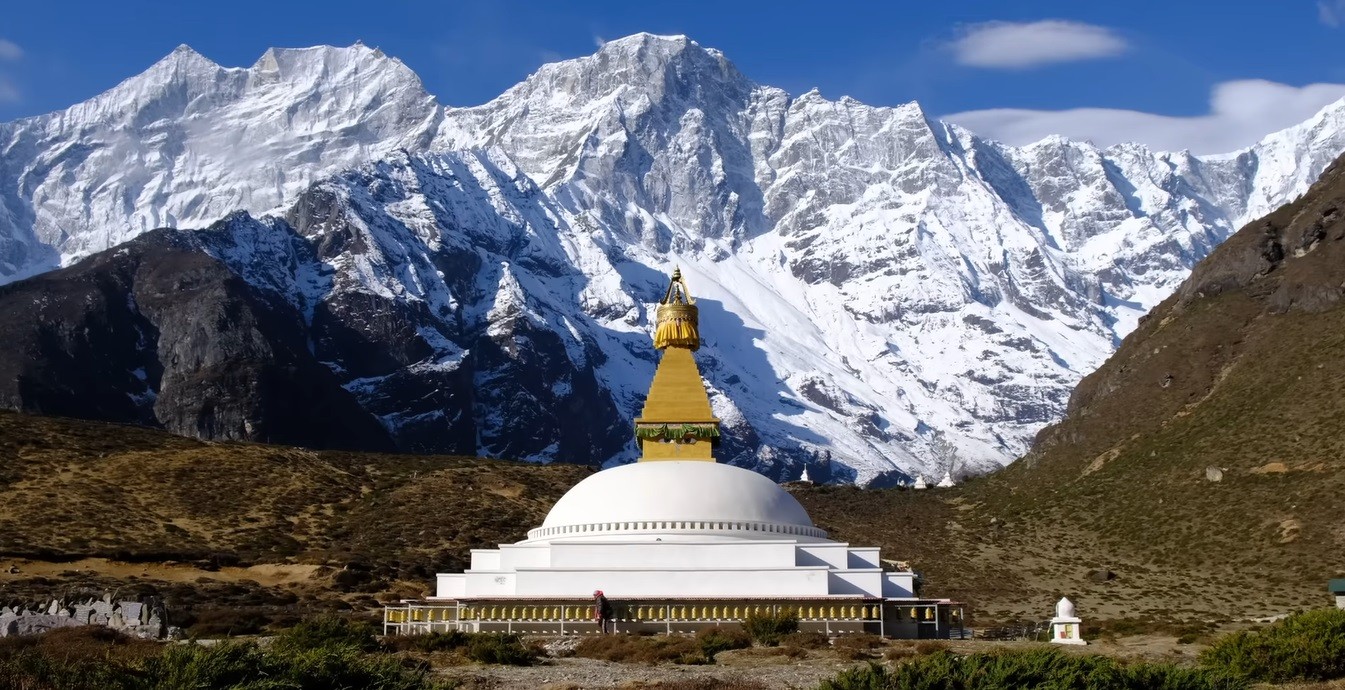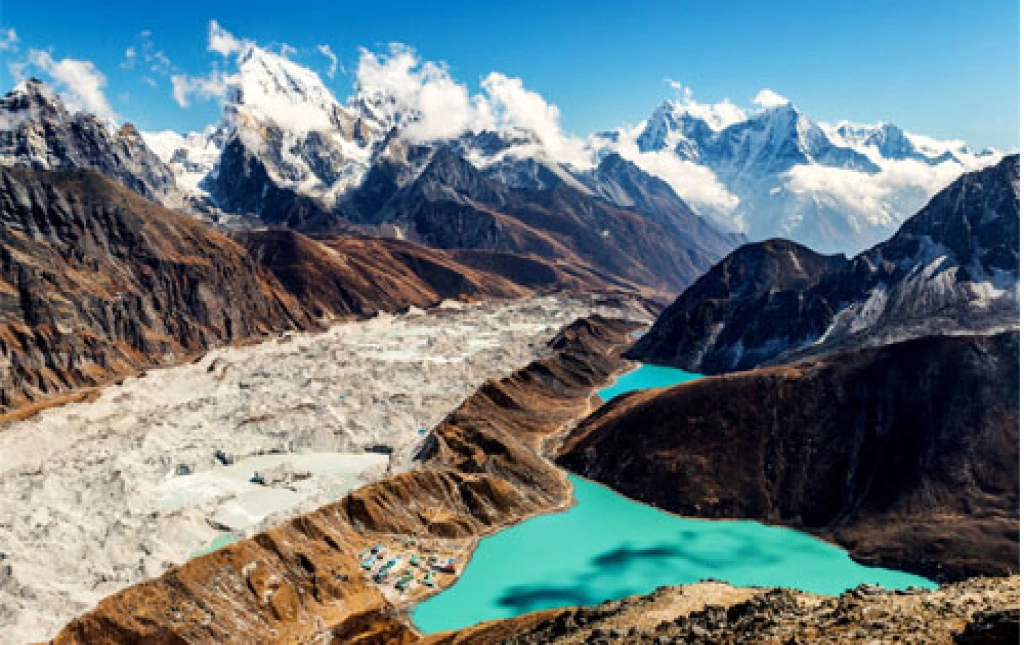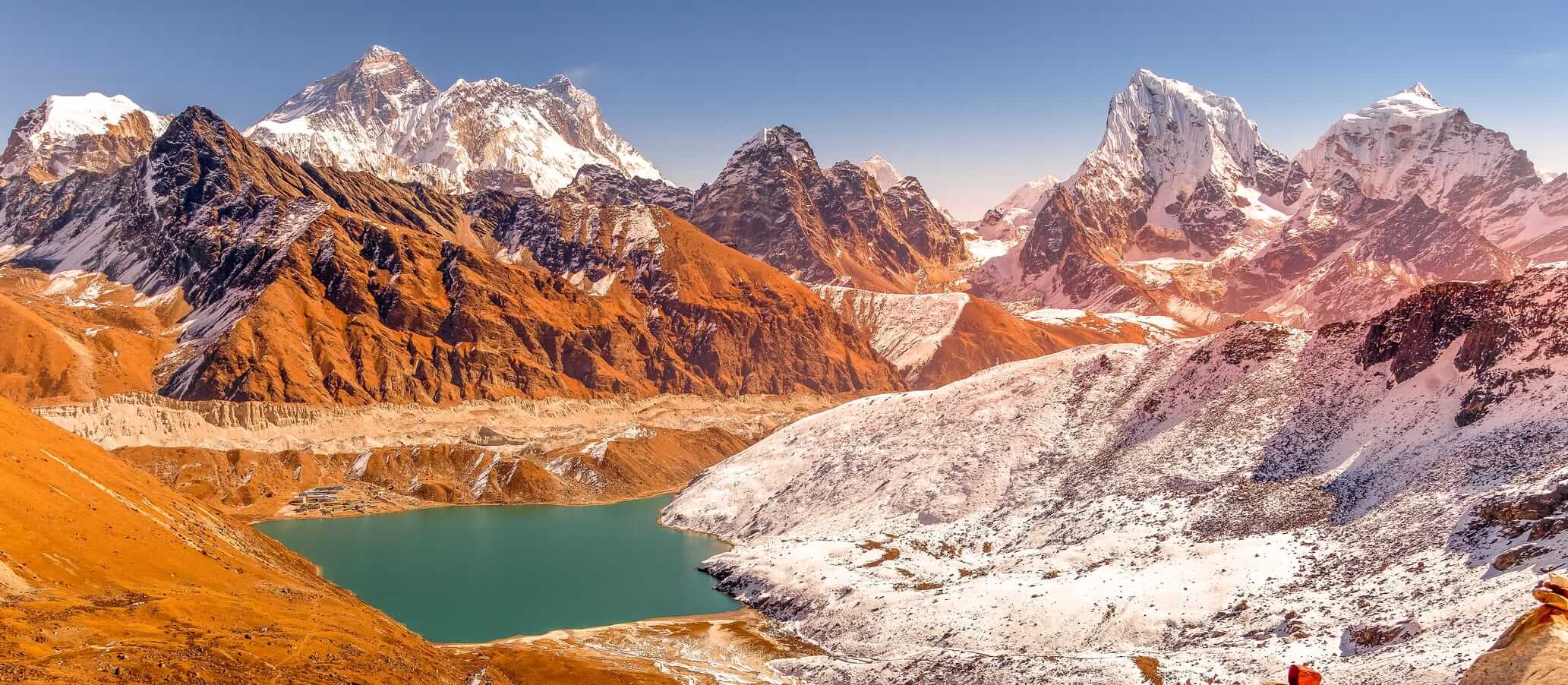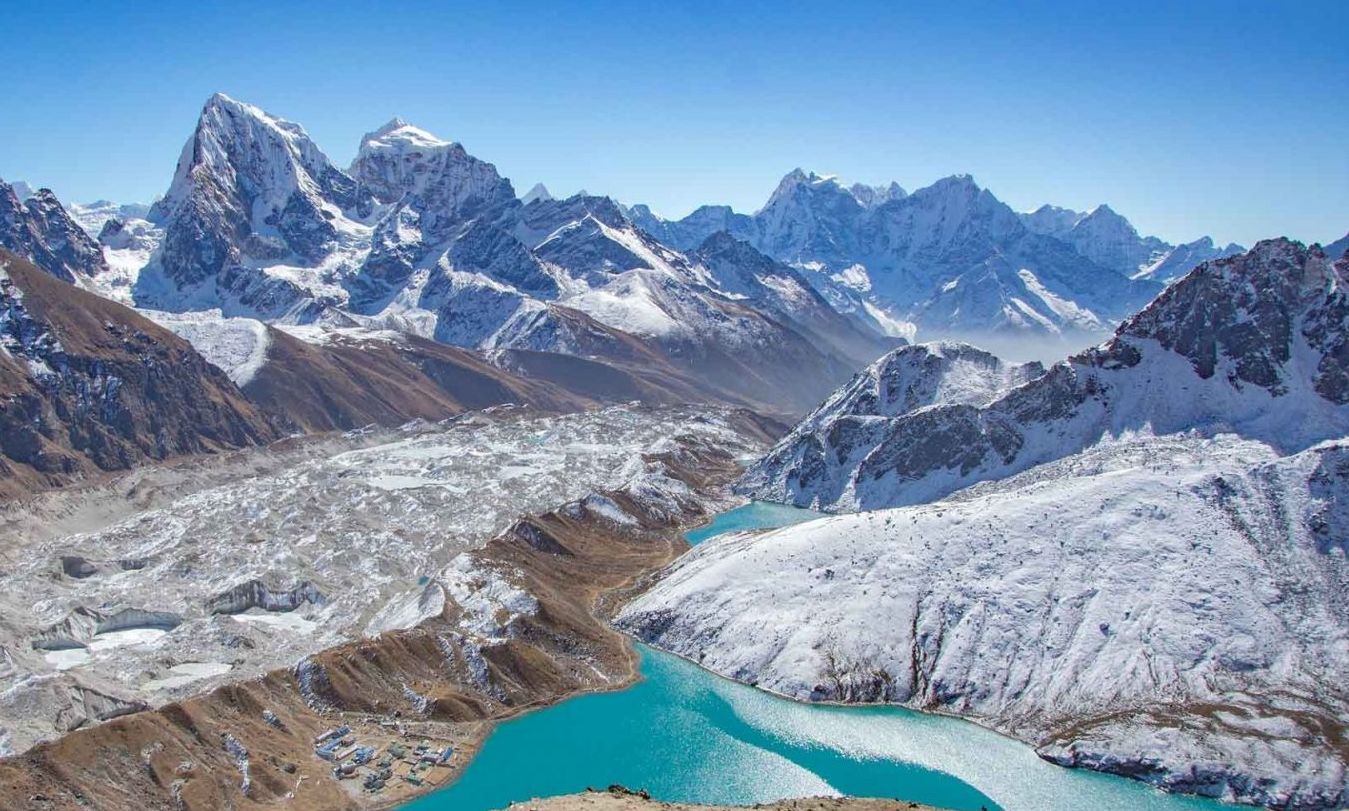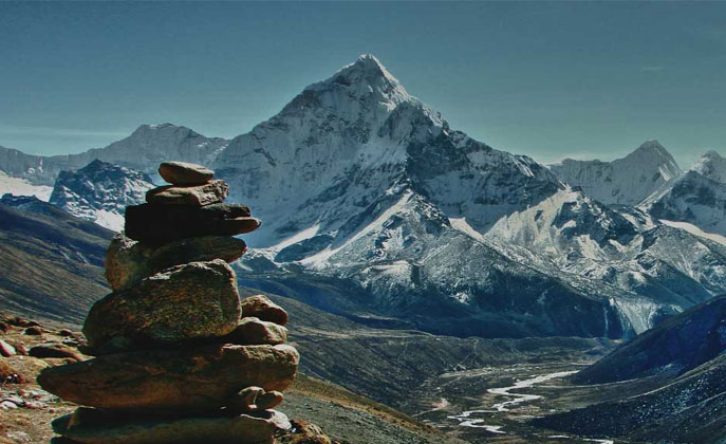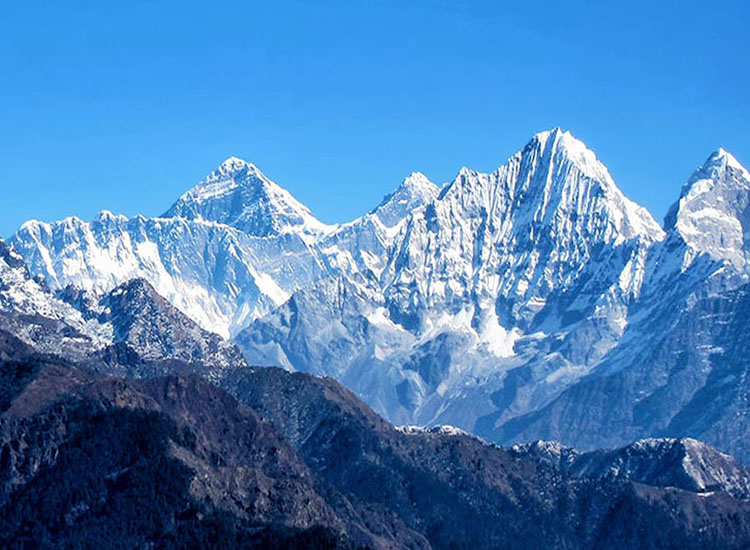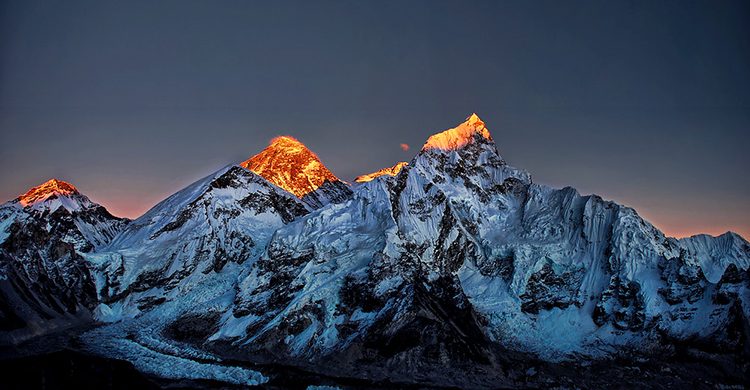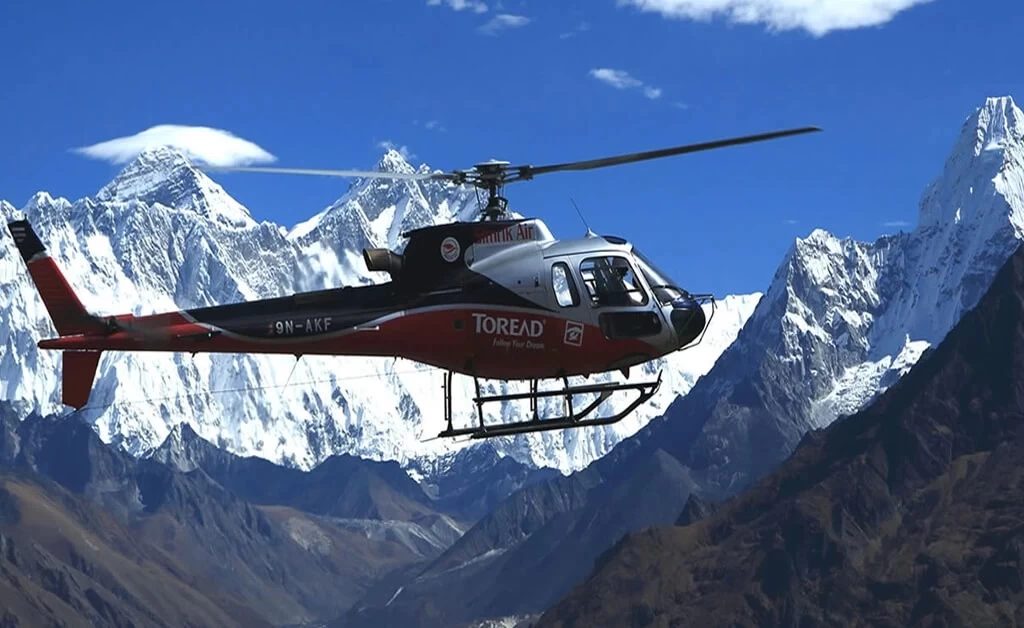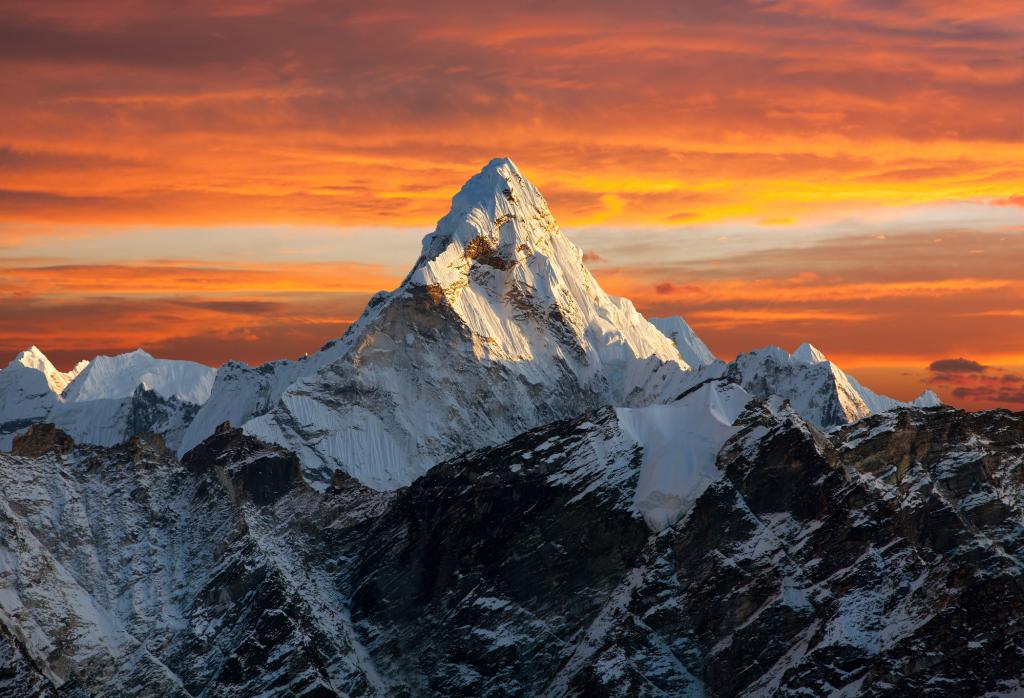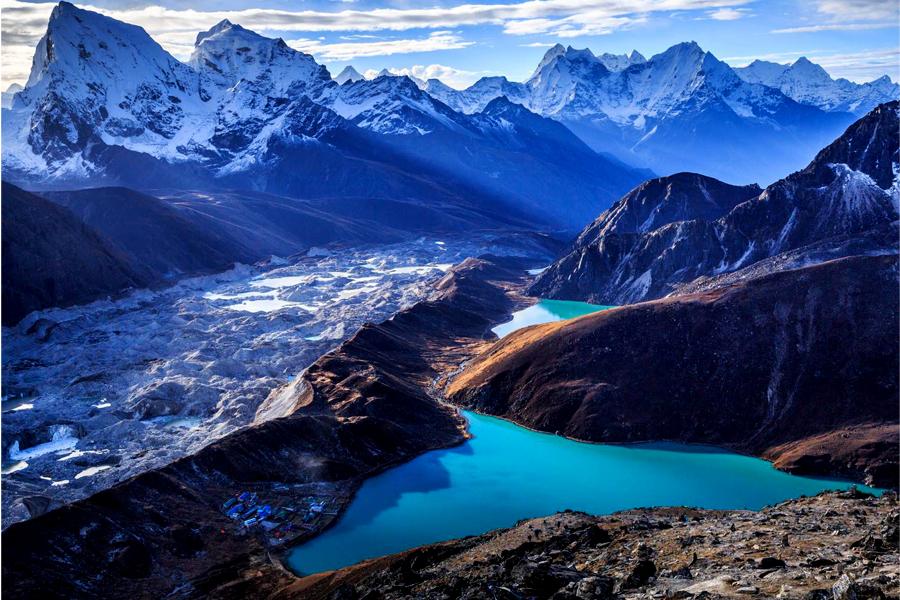Trip Facts
Trip Highlights
- Nepal's top trekking destination – longest and most challenging trekking adventure
- Three high-passes leading to Gokyo Valley – Kongma La, Cho La & Renjo La
- Fly between giant mountains – heart-pounding moments landing at Lukla airport
- It offers amazing scenery and views
- 10+ years' experience local guide and porters
- Acute Altitude Sickness friendly itinerary
- Visit Sherpa settlements, observe their culture, and enjoy their hospitality
- Come across high suspension hanging bridges, pristine lakes, roaring rivers, glaciers,and pass yak pastures and valleys
- Highest altitude situated Monastery (Gompa), Meet Buddhist Lama, Monks & Nuns, Tibetan Buddhism, and Practices
- 2 Days’ Acclimatization (First: Namche, Second: Dingboche) and 1 Day Rest (Gokyo Ri – 5,360m/17,584ft)
- Closure view of Himalayas en-route to Everest Base Camp and return
- Step on the Highest Base Camp – Everest Base camp
- Magnificent view of Mount Everest Sunrise and Sunset from Kala Patthar
- Tea houses, guest houses, and luxury lodges with hygiene meals
- Breath air at the altitude of 7,000 to 8,000 m peaks
- Walk in the habitat of rare and endangered species – snow leopard, red panda, Himalayan black dear, musk deer, and Himalayan wolves.
- Extensive pasture for yaks and pristine turquoise lake
Overview
Everest Three High Passes Trek is your adventurous journey in the magical and spiritual land of the Himalayas. On your Trek, you pass through several ridges, cross rivers, and hang bridges, see wild animals and birds, witness appealing landscapes, and observe the heart-touching story of the local people or their lifestyles. You will feel overjoyed to capture the best moments in the sacred Himalayas.
This trek links Everest Base Camp Trek and Gokyo Lake Trek with two more trails to the east and west of the center region. Also, it includes Three Everest High Passes (each over 5,300m). You get time for acclimatization, rest, and restoring your energy. You can start and accomplish this topmost ‘Everest Three High Passes Trip’ either clockwise or anticlockwise.
Your journey starts with a 30–35-minute short scenic mountain flight to Lukla from Kathmandu. From Lukla, your real trekking begins. After two days of the Trek, you reach Namche Bazaar, acclimatize, and rest here. At Namche, you explore the Sherpa villages of the Khumjung Region, observe their lifestyle, and enjoy their culture/beliefs.
The eastern section includes a climb up to Chhukung for two nights of acclimatization and a hike to Chhukung Ri or Island Peak Base Camp for views of the Lhotse and Ama Dablam glaciers. You can shelter at teahouses, or you will find a suitable camping site in the natural setting.
Overcome the Kongma La en way to Lobuche and Everest Base Camp (5535m). Then, return to Duglha, climb to the Cho La (5368m), and descend steeply to Thangnak. Then, cross the Ngozumpa Glacier and continue to Gokyo, where you may climb Gokyo Ri for breathtaking views of Nepal’s longest glacier, Cho Oyo, and the Everest range.
Everest Three Pass Trek is one of the longest and most challenging treks in the Everest region. The trails are full of boulders, ice crevasses, zigzags paths, and slippery ice-covered stones. Be conscious while strolling through the trails. In the Everest Region, the climate is bizarre, windy, cold, and risk AMS while ascending to higher altitudes.
Book your Everest Three High Pass Trek with Nomadways Adventure. We promise you to provide the best quality trekking services, security, proper guidance, and assistance. So be ready to collect the most beautiful memories, natural-thrilling moments, and life-changing activities.
Itinenary
When you land at the Tribhuvan International Airport, our representative will greet you and transport you to your luxury hotel/guesthouse and assist you to check-in. So, look for someone holding a placard with your name or our company’s name – Nomadways Adventure– waiting for you.
On this day, you simply relax at Hotel/Guesthouse overnight and restore your energy to accomplish your upcoming adventurous trip.
Our company organizes a short introductory meeting in the evening. You will meet your trekking guide, and our trekking expert will provide you with all the detailed information about the Everest Three High Pass Trek.
On this day, you are going to enjoy the Kathmandu Valley Tour – the city full of World Heritage Sites, Nepali Culture, and many more to explore.
We offer you a warm breakfast at dawn, and your sightseeing starts with our city guide. At first, you visit Pashupatinath Temple – the holiest Hindu Temple on the bank of the sacred Bagmati River, then move to Boudhanath Stupa – the most significant Buddhist Stupa architecture in the world. After that, we will drive you to Patan Durbar Square. In addition, we take you to Swayambhunath Stupa – the 2000 years old legendary stupa on the hilltop also nick-named as Monkey Temple. In the end, we come to Kathmandu Durbar Square, observe Kumari Temple (Living Goddess Temple), Nautale Durbar, the Kaal Bhairav, the Swet Bhairav, the freak streets, and more.
Your city tour ends in the evening. So, you take a light dinner and take a rest restoring energy for the upcoming adventure.
We take an early morning flight (30-40 minutes) from Kathmandu to Lukla. As the plane passes between towering mountains, the flight offers you the heart-pounding experience of the turbulence and tranquil picturesque of the Himalayan range. Finally, you land at Lukla airport – the gateway to the Everest Region.
How would you feel landing on the airport with just a single runway on a cliff ? You will get surprised, right? Lukla Airport is one of the most dangerous airports in the world.
At Lukla, you get to rest for some time, meet your local porters and arrange the luggage.
From Lukla, after showing your Trekking Permit at the Lukla checkpoint, your footsteps head towards Phakding – a Sherpa village renowned for the 500 years old monastery. You follow the trails down to Thalsaroa, and then to Cheplung. Then, the trail traces along Dudh Koshi valley, enjoying the introductory view of Mt. Khumbila (5,761m/18901ft). You continue your pace for a few hours and reach Ghat (2,520m/8,350ft). Further a short walk from Ghat, we reach Phakding – our today’s destination. Enjoy the best hotel, hygienic cuisine, and friendly hospitality with superb service at Phakding.
On this day, we trek from Phakding to Namche – the most significant tourism hub in the Everest region.
Passing through the dense fir, alpine, and rhododendron forest along Dudh Koshi River, we go up to Benkar. From Benkar, we further walk through dense forest and cross suspension bridges which take us to Chhumuwa and Monjo.
At Monjo, you must register your trekking permit at the check-post and then trek inside the Sagarmatha National Park. You feel completely enthusiastic about the wonderful environment of the park. Also, you may encounter wild animals and several species of vegetation. Watch them out !
Ahead, we cross the Tenzing-Hillary suspension bridge over Dudh-Koshi River ascend via the pine and fir forest to the ridge.
We have the first glimpse of Mt. Everest on the trail toward the ridge. Enjoy it.
Continue your pace uphill pace for a couple of hours; finally, you arrive at Namche Bazaar. Enjoy the rest of your time at Namche – standard lodging and modern facilities like ATMs, Internet, Cyber Cafes, Pubs, and Restaurants.
Today, we acclimate, explore, and rest in Namche.
As a part of acclimatization, after taking breakfast, we walk towards the Sagarmatha National Park Museum. Enjoy and learn about the Sherpa culture, local flora, and fauna of this region.
After leaving the museum, we head towards the Everest View Hotel – one of the world’s highest hotels. You find yourself speechless when you see the panoramic view of snow-capped mountains such as Mt. Khumbila (5,761m/18,901ft), Mt. Thamserku(6,623m/21,729ft), Mt. Everest(8,848m/29,029ft), Lhotse(8,516m/27,940ft) and Ama Dablam(6,812m/22,349ft) mirroring and shining in front of you.
Other places to explore are Khumjung and Kunde villages with Hillary school, Hillary Hospital, and Syangboche Airstrip.
In the end, you come down to Namche Bazaar. We take a rest or explore the beautiful tourist hub and enjoy other facilities at Namche Bazaar.
Tengboche is well-known for the Tengboche Gompa – one of the oldest monasteries of this region. Inspect evening prayer at Gompa and enjoy comfy accommodation and delicious meals.
After taking an early breakfast, we start climbing up to the Namche village. On the way, we visualize a spectacular view of Mt. Everest.
A few hours walk from Namche takes to Sanasa junction – the intersection of Everest Base Camp Trek and Gokyo Lake trek. We take a right turn to get to EBC. Trekking down to the villages Lawichasa and Tashinga with the majestic view of sparkling Ama Dablam(6856m/22,493ft) and walking again, we reach Phunki Thanga. After enjoying lunch at Phunki, we climb to Tengboche, passing through the dense rhododendron, juniper, and alpine forest.
Tengboche is well-known for the Tengboche Gompa – one of the oldest monasteries of this region. Inspect evening prayer at Gompa and enjoy comfortable lodging and delicious meals.
At dawn, we take a warm breakfast at Tengboche and follow the trails to Dingboche. Trekking along the stone-paved trail, we reach Debuche. Visit Debuche Nunnery to inspect the Thanka paintings, Mural paintings, and architecture. Here, you can take a rest for some time.
After that, we continued our hiking from Debuche and reached Pangboche. From Pangboche, we descend to Somare then to Orso. Further, we cross a suspension bridge over the Imja River. Then, walking for a few hours alongside the Imja River, we reach the summer village, Dingboche – the last human settlements at this higher altitude. We spend a pleasant night here, enjoy light meals, and rest.
This is the second acclimatization day after Namche.
As scheduled, after breakfast, we start trekking from the north ridge of Dingboche and climb to Nangkar Tshang Peak(5,616m/18,425ft). From the peak, we observe the wonderful glimpse of snow-capped peaks Mt. Makalu(8,463m/21,204ft), Ama Dablam(6,856m/22,493ft), Island peak(6,189m/20,305ft), and Thamserku(6623m/21,729ft). Finally, after completely relishing nature’s beauty, we come back to Dingboche.
In the evening, we catch the finest moment of late sunshine. Then, we enjoy hygienic meals and take proper rest.
This day, we trek from Dingboche, passing by stone-walled meadows and alpine scenery. Next, we capture breath taking views strolling to the top of Imja Valley. Further, we cross the valley, Lhotse towers on our left and Ama Dablam on our right. Finally, we reach Bible(4570m), a yak herdsman’s camp, after trekking nearly 3 kilometers. The Island Peak(Imja Tse: 6189m), a famous hiking peak, rises straight ahead. Then, we come to Chhukung after a 30-minute stroll from Bibre.
We take lunch here at Chhukung. Then, we may take a walk to Chhukung Ri, a rocky knoll at 5546 meters that provides spectacular views of Lhotse, Island Peak, Ama Dablam, Makalu, and numerous other peaks, including Baruntse.
On this third rest day, we acclimatize in Chhukung before setting off for the pass. We walk up to the moraines towards Island Peak (6189 m). Along the Lhotse Glacier, we ascend to the Island Peak Base Camp (4970 m), passing the swollen water of Imja Lake. To the north, Lhotse’s huge south face rises above, while to the south, Amphu Lapcha Pass (5845 m) and the gigantic, fluted ice walls that border it dominates the horizon. The eastern face of Ama Dablam, to the southwest, gives a unique panorama of this glorious summit.
After acclimatizing at Chhukung, we continue our trek to cross the highest pass of the journey. You find no lodges along the way, so carry plenty of water, snacks, and a packed lunch. We will enjoy a lot being in such an isolated, remote place and close to nature. We have two options; climb over the hill northwest of Chhukung to the Nuptse Glacier moraine or walk down the valley to Bibre and a high path above the Niyang Khola. After a short hike, you can have spectacular views of the Island Peak Valley and Amphu Lapcha’s rocky mountain.
The next, we go down to the Niyang Khola Valley’s east side before turning west and walking through the muddy stony trail. Finally, we reach a large area with a smattering of tiny ice lakes. After five hours on the path from Chhukung, we come to the Kongma La. We see a landmark covered in prayer flags as we neared the summit, marking the pass. A panorama of ice lakes lies in front of us, with the Khumbu Glacier. The last drop is the most challenging part of the journey today. The path swings north after climbing the moraine on the other side and leads us to Lobuche through the Khumbu Glacier.
Today, your dream of climbing the world’s highest base camp comes true. So, you feel more excited, more enthusiastic.
We start following the narrow mountain gaps and glacial moraine, taking a warm breakfast. Then, keeping our pace for 2-3 hours on the rocky path, we reach Gorakshep – the last human settlement. Here, you check-in at the hotel and leave your heavy loads behind.
Following the right side of Gorakshep, we ascend for 2-3 hours trekking through the rocky sandpit and boulders alongside the glacial river of the world’s highest Khumbu glacier. Finally, we reach our final destination of the Everest region, Everest Base Camp (5,364m).
Enjoy the perfect landscape, 360° view of Mountains like Nuptse-Lhotse, and Khumbu glacier just above EBC. You can meet other international trekkers, enjoy your time, capture the best moments, celebrate your victory, and exchange happiness with one another.
For some time, you feel lost in the outstanding beauty of the Everest Region – Everest Base Camp. Then, we drop down to Gorakshep, enjoy a warm meal and take a rest in the cozy lodging.
In fact, we cannot see Mt. Everest clearly and exactly from EBC. So, we arrange a side trip to the Kala Patthar Summit (5,550m/18,208ft). You enjoy a spectacular sunrise view touching the Mt. Everest peak and a 360° view of snow-capped mountains.
We leave from Gorakshep at 4 am for Kala Patthar to capture this moment. A couple of hours tracing down, we reach the Kala Patthar pinnacle. Our eyes continuously watch, enjoy and capture a 360° view of mountains like Mt. Everest (8848m/29029ft), Mt. Lingtren(6,749m/22,142ft), Khumbutse(6,636m/21,771ft), Nuptse(7,861m/25,790ft) and Pumori(7,161m/23,494ft).
After completing the Kala Patthar Trek, we descend from Gorakshep to Lobuche. After lunch, the path to Dzonglha splits off from the main trail some distance from Lobuche. We keep going down. The route climbs across a grassy slope to the southeast, from where we can see the towering heights of Ama Dablam and Kangtega-Thamserku, while Tawache looms large ahead.
The route climbs across a grassy slope to the southeast, from where we can see the towering heights of Ama Dablam and Kangtega-Thamserku, while Tawache looms large ahead. You can see Pheriche village floored down in the valley. The huge Cho La Lake stretches underneath Mt. Cholatse as the ridge veers northward.
The lake follows us for a long time until we reach a large basin. Then, the route ascends a spur before descending steeply to another large basin. We arrive at Dzonglha after a one-hour trek across the basin and crossing a swaying bridge shortly after.
The breathtaking sight of Cholatse looming over greets us early in the morning. Today will be one of the most difficult days of our journey. From Dzongla, we begin our trip westward. We reach the top of the basin in about an hour, ready for the Chola victory. The view back becomes more fascinating as we gain altitude – the Cho La Lake appears, the Ama Dablam rises to the south, and Cholatse rises to the west. Climbing is difficult, and be cautious of ice-covered rocks. Prayer flags are stretched over cairns and fluttering in the fierce wind as we approach the top. The scenery is magnificent, with beautiful peaks in every direction.
If rocks are coated with ice, be cautious while descending to Thangnak. Finally, we reach Thangnak, a small hamlet. Stepping out of the settlement, magnificent mountain sights welcome us. After a short hike, we arrive at the Ngozumpa glacier’s edge, Nepal’s longest glacier. As we approach the opposite side of the glacier, we catch a glimpse of the second of the six Gokyo lakes. The third Gokyo Lake is only a short distance distant. The Gokyo Village, which sits on the shore of this lake, is where we finally rest our exhausted bodies.
You can find wonderful views in the Gokyo region. First, climb Gokyo Ri(5350 m), the tiny peak above the lake, for the finest view. The summit is reached after a two-hour hike and offers panoramic views of Cho Oyu, Gyanchung King, Mt. Everest, Lhotse, Makalu, Cholatse, Tawache, and other peaks.
If you have more time and vigor, you can hike up the valley to another lake, Ngazumpa, or even farther to a fifth lake.There are a number of minor peaks in this area that provides main points for the surrounding peaks and views of the Nangpa La– the historic trade route into Tibet.
Today, we proceed early from the Gokyo Valley. Leaving the main track, we turn to Renjo La path by Dudh Pokhari. We arrive at the Renjo La after approximately 3 hours and are greeted by a breathtaking view. The light shines brightly on Mount Everest, Lhotse, Cholatse, and Taboche. Renjo La has views that are similar to Gokyo Ri, and Gokyo settlementis visible behind the gray slur of Ngozumpa Glacier.
Continuing up from the pass, the trail descends stone staircases to the lake, Angladumba Tsho. Further, we pass via Relama Tsho and Renjo Lake on our trip. First, however, we stroll down through a narrow valley congested with giant boulders to Lumden. Next, we travel about an hour from Lumden(4350m) to Marlung, on the Bhote Koshi’s east bank.
We spend a night at Marlung.
From Marlung, we stroll down a traditional route used for centuries by the Tibetan traders to reach Thame. First, we descend to Taranga after crossing the Bhote Koshi.Then, we pass through Langmuche Khola valley. This stream drains down from Dig Tsho, the glacial lake that burst in 1985, causing disastrous floods along the Dudh Kosi Valley to the Thame moraine.
We go down, cross a bridge and reach the Same, where we observe incredible views. Further, the path steeply descends to Thamo village, which hosts Khari Goma’s Monastery. This is a nunnery being home to some nuns and monks. Next, we reach the small village of Phurte where Laudo monastery is run by the Kopan Monastery of Bouddhanath in Kathmandu and is popular among Westerners for Buddhist study and meditation centers. We eventually reach Namche.
Today, we depart from Namche, follow the trails down to the Dudh Koshi River, and retrace our steps to Monjo and Cheplung via the Sagarmatha National Park pathways. You will never forget the excitement of crossing a suspension bridge, walking through deep alpine and rhododendron woods, and hiking along rocky terrain.From Cheplung, we climb for more than half an hour and reach Lukla.
In the evening, you can participate in the farewell program; thank your hard-working and ever-smiling porters. Also, give yourself a total rest.
On this second last day of your trek, we fly back to Kathmandu from Lukla. Restore your memories in the plane flying between giant mountains. After landing at TIA, you will be transferred to your hotel.
Relax !
Also, you can explore local markets nearby, taste Nepali and other continental cuisines at various restaurants and observe the hustle-bustle lifestyle in Kathmandu.
On this final day, after having light breakfast, we transfer you to the Tribhuvan International Airport via private transportation. We bid you a happy ‘Goodbye’ and wish you a safe flight.
Cost Includes
- All airport transfers
- Luxury Hotel in Kathmandu for two nights with breakfast
- Flights Kathmandu–Lukla–Kathmandu
- All airport taxes
- All necessary paperwork and trekking permits (National Park permit and TIMS)
- An experienced English-speaking Govt. registered trekking guide and local porters to carry luggage (2 trekkers: 1 porter)
- Guide and porter salaries, insurance, equipment, transport, food, and lodging
- Full meals: Breakfast, Lunch & Dinner of your choice
- Supplementary snacks: energy bar and cookies
- Seasonal fresh fruits desert every day
- Unlimited Chlorine treated Safe Drinking water
- Accommodation: Lodge
- A comprehensive First Aid kit
- Oxi-meter: To check heart rating and oxygen saturation to Everest Base Camp and return
- All government and local taxes
- Trekking equipment: down-filled sleeping bag, walking poles, and duffel bag
- Souvenir: Trekking Route map printed T-Shirts
Cost Excludes
- Lunch and dinner in Kathmandu
- Hot and bottled drinks
- Electronic device re-charge
- Wi-Fi
- Hot shower
- Travel insurance and medical evacuation
- Tipping
Equipment
Trekking requires careful selection of gear to ensure comfort, safety, and efficiency on the trail. Depending on the conditions (terrain, weather, duration), the equipment you need may vary, but here’s a comprehensive list of essential trekking gear:
- Backpack
- Capacity: Typically, for a multi-day trek, a 40-60L pack is ideal.
- Fit: Adjustable straps for shoulder, chest, and hip.
- Features: Hydration system compatibility, side pockets for easy access, and a rain cover.
- Footwear
- Trekking Boots: Look for boots with good ankle support, durable soles (Vibram is a popular choice), and waterproof features.
- Trail Shoes: For lighter treks or well-maintained paths, trail shoes may suffice.
- Sock Layers: Merino wool socks or synthetic socks that wick moisture and reduce blisters. Avoid cotton.
- Gaiters: To keep debris, mud, and snow out of your boots.
- Clothing (Layering System)
- Base Layer: Moisture-wicking (synthetic or merino wool) long-sleeve top and bottoms.
- Mid Layer: Insulating layer, such as a fleece or down jacket.
- Outer Layer (Shell): Waterproof, windproof jacket and pants. Gore-Tex or similar fabrics are excellent choices.
- Trekking Pants: Convertible pants (with zippers for shorts) can be useful.
- Trekking Shirt: Lightweight, moisture-wicking, and quick-drying.
- Gloves: Lightweight gloves for warmth, plus an additional heavier pair if trekking in cold climates.
- Hat/Cap: A sunhat or beanie depending on the weather.
- Neck Gaiter/Buff: For sun protection, warmth, or dust.
- Sleeping Gear
- Sleeping Bag: Temperature-rated for the conditions you’ll face. Down bags are warmer and lighter but lose effectiveness if wet, while synthetic bags dry quicker.
- Sleeping Pad: Inflatable or foam pads that insulate from the cold ground.
- Tent: Lightweight trekking tents (1-3 person) that suit your conditions. Some options include 4-season tents if you're trekking in harsh weather.
- Hydration System
- Water Bottles: Collapsible or hard plastic bottles (ensure they’re BPA-free).
- Hydration Reservoir: Camelbak or similar bladder systems for easy access to water.
- Water Purification: A filtration system (e.g., Sawyer, LifeStraw) or chemical tablets to purify water from streams or other sources.
- Food and Cooking
- Stove: Compact gas or alcohol stove for cooking on the trail.
- Cookware: Lightweight pots or pans, often titanium or aluminum.
- Fuel: Compatible fuel for your stove (check for availability in the region you’re trekking).
- Food: Dehydrated meals, energy bars, trail mix, nuts, and fruits. Lightweight, high-calorie, and easy-to-prepare foods are best.
- Navigation Tools
- Map and Compass: Always have a paper map as a backup, even if you use a GPS.
- GPS Device or Smartphone with a Trekking App: Make sure to download offline maps.
- Altimeter Watch (optional): Useful for tracking elevation and route progress.
- Lighting
- Headlamp: Hands-free lighting for night-time use, with extra batteries.
- Flashlight: A backup to your headlamp.
- First Aid Kit
- Include basic supplies: Bandages, antiseptic wipes, blister treatment, pain relievers, and any personal medications.
- Personal Medications: Always bring enough for the whole trip, plus extras in case of delays.
- Sunscreen and Lip Balm: Protect your skin from sun exposure.
- Safety Gear
- Multi-tool/Knife: A good multi-tool (like a Swiss Army Knife or Leatherman) is very useful for repairs and emergencies.
- Whistle: For signaling.
- Emergency Blanket: Lightweight and compact for warmth in case of emergency.
- Firestarter: Matches or a lighter, and waterproof if needed.
- Miscellaneous
- Trekking Poles: Help with balance, reduce strain on knees, and improve traction on uneven terrain.
- Towel: Quick-dry, compact towel.
- Sunglasses: UV protection for your eyes.
- Camera/Smartphone: For documenting the journey, with extra storage or a portable charger.
- Personal Hygiene and Toiletries
- Toilet Paper: Always carry biodegradable toilet paper and a small trowel for digging a "cathole" if there are no facilities.
- Hand Sanitizer: To keep clean without access to water.
- Wet Wipes: For cleaning yourself when there's no shower.
- Biodegradable Soap: If you need to wash, use eco-friendly soap.
- Toothbrush/Toothpaste: Compact travel versions.
- Weather Protection
- Sun Protection: Sunglasses, sunblock, and a wide-brimmed hat for sun protection.
- Rain Gear: A high-quality waterproof jacket, pants, and gaiters, especially if you're trekking in areas with unpredictable weather.
- Cold Weather Gear (if needed): Depending on the trek, you might need additional gear like down jackets, insulated gloves, or even crampons for ice or snow.
- High-altitude Treks: Consider gear for altitude sickness (like Diamox), extra layers for extreme cold, and an oxygen system if necessary.
- Long-distance Treks: You might need additional gear like extra food storage, a larger stove, or a lightweight trekking umbrella.
FAQ's
The Everest Three High Pass Trek is a challenging circuit trek that takes you over three high passes in the Everest region: Renjo La, Cho La, and Kongma La. It provides stunning views of the Everest, Lhotse, Makalu, and other peaks, and offers a chance to explore remote Sherpa villages, monasteries, and the Everest Base Camp.
The trek is difficult and challenging, suited for experienced trekkers with a high level of fitness. The high passes require trekking at altitudes above 5,000 meters, and some of the paths are technical, requiring careful navigation. Proper acclimatization is critical to avoid altitude sickness.
The highest point is Kongma La Pass at 5,535 meters (18,159 feet). This is the most challenging of the three high passes due to its steep ascent and rugged terrain.
Key items to pack include: Warm layers: Insulated jacket, fleece, thermal underwear Headwear: Warm hat, bandana, or sun hat Footwear: Waterproof trekking boots, gaiters, and warm socks Sleeping bag rated for cold temperatures Trekking poles for support on steep terrain First aid kit, personal medications, and water purification tablets Sunglasses, sunscreen, and lip balm with SPF Camera to capture the stunning views!
